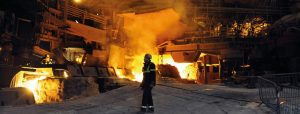How LED Lighting Benefits High Temperature Facilities
By Leah • May 30, 2019
Many industries require high temperature facilities to produce or process, creating various hazards out of necessity. While there will always be a certain amount of risk required for these industrial processes, this doesn't mean we can't work on ways to reduce this risk to a minimum. While it may not be immediately obvious, using LED can help in this drive to minimize risk.
What are High Temperature Facilities?
While it might seem like an obvious question, it is easy to underestimate just how hot certain industries can be. Some facilities such as steel mills require extreme temperatures to process these metals. Iron (the element used to make steel) has a melting point of 2750°F, so smelting iron to create steel and then casting it in molds requires extremely high temperatures.
Any foundry will need high temperatures, as do power generation facilities such as nuclear power plants. There are also less obvious high temperature facilities such as chemical processing plants. Oil needs temperatures exceeding 1000°F to refine its crude state, but even seemingly innocuous places such as industrial food production can generate a lot of heat.

Lighting and Ambient Temperature
These high temperature processes mean that the ambient temperature is raised. For human beings to be in these facilities and work without suffering negative effects, the environment needs to be carefully controlled. Some plants will have large ventilation units, industrial cooling facilities or even use the outdoors to allow heat to escape.
Everything within the facility will either add or detract from the temperature, even the body heat of workers themselves. Lighting can also add to this heat.
High intensity discharge bulbs such as metal halide or high pressure sodium lamps require a lot of electrical energy just to start them. This is why they use ballasts to control the electrical flow required to ignite the arc between electrodes. This arc is what creates the light in the bulb.
Unfortunately, a lot of this electrical energy is also converted into heat energy. With industrial HIDs, the large bulbs emit a lot of heat energy per bulb. Multiply this by the vast amount of bulbs required to sufficiently light these indoor commercial properties and they add considerably more heat to an already roasted environment. This extra heat puts more pressure on cooling systems to maintain workable ambient temperatures.
Why LED Lighting Can Help
LED lighting is up to 80% more energy efficient than HIDs and other more traditional lighting products. This means you get the same amount and quality of light using much less energy. Not only this, but minimal energy is wasted as a heat by-product.
The less heat added to the ambient temperature, the less strain it puts on temperature regulators and the less energy you use for these devices.
Another reason LED lighting is beneficial for high temperature environments is due to its fixture requirements. To house the gas and electrodes needed for HIDs to function, the lamps are encased in reinforced glass. This limits the directional ability of the light and provides a safety hazard.
LED lighting can be used in reinforced casings which don't need as much space to function. This means you can concentrate a lot of light and keep it behind safer fixtures. You can keep them higher up and away from heat sources and still maintain the same quality of heat. Also, programming and motions sensors mean the amount of energy being used at any one time can be more carefully maintained than lighting which is too outdated for this technology.
